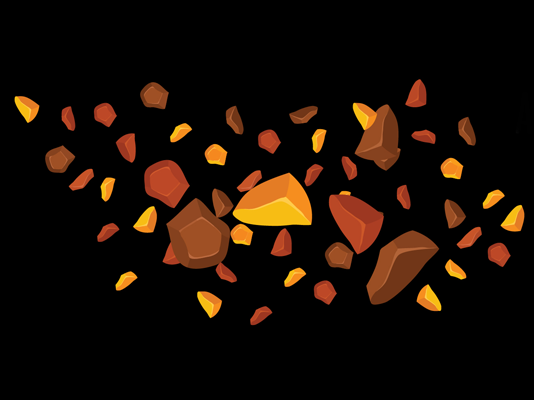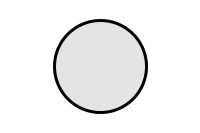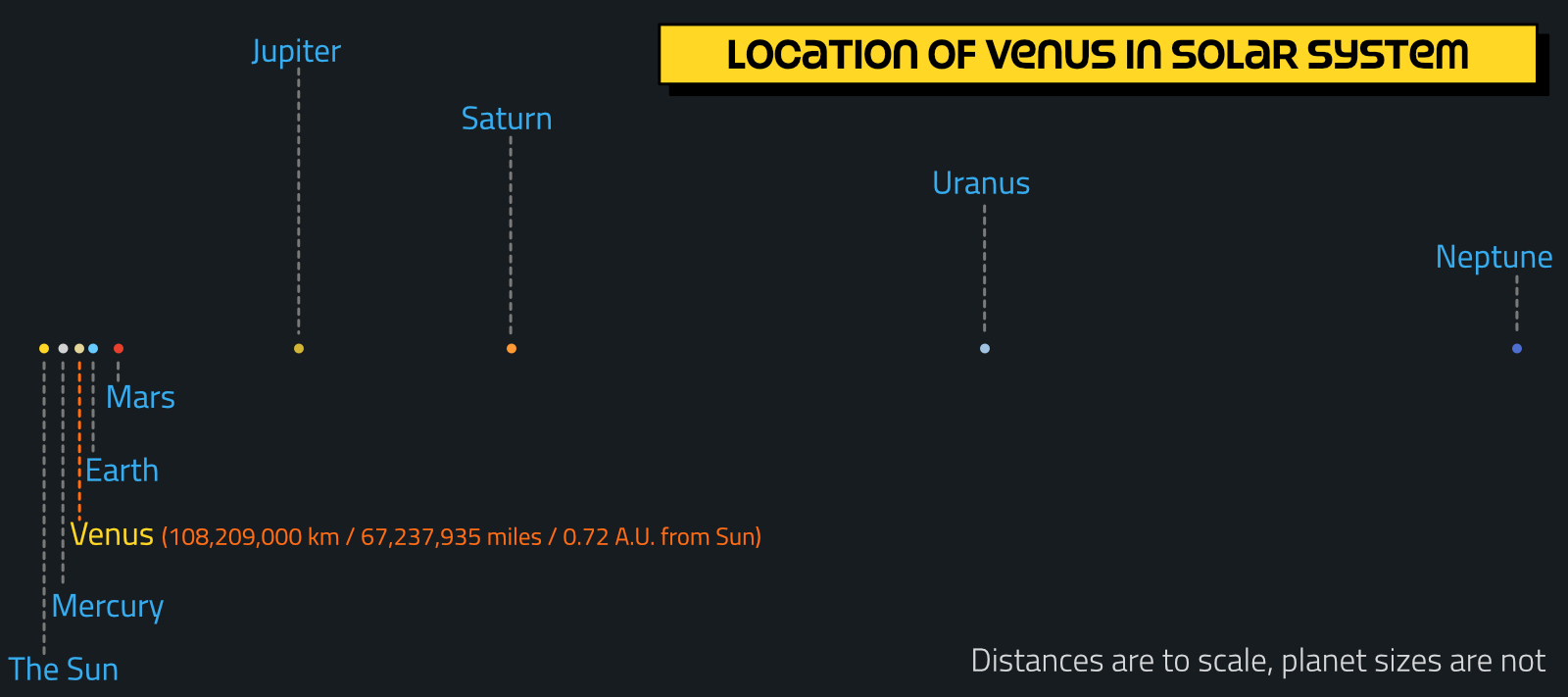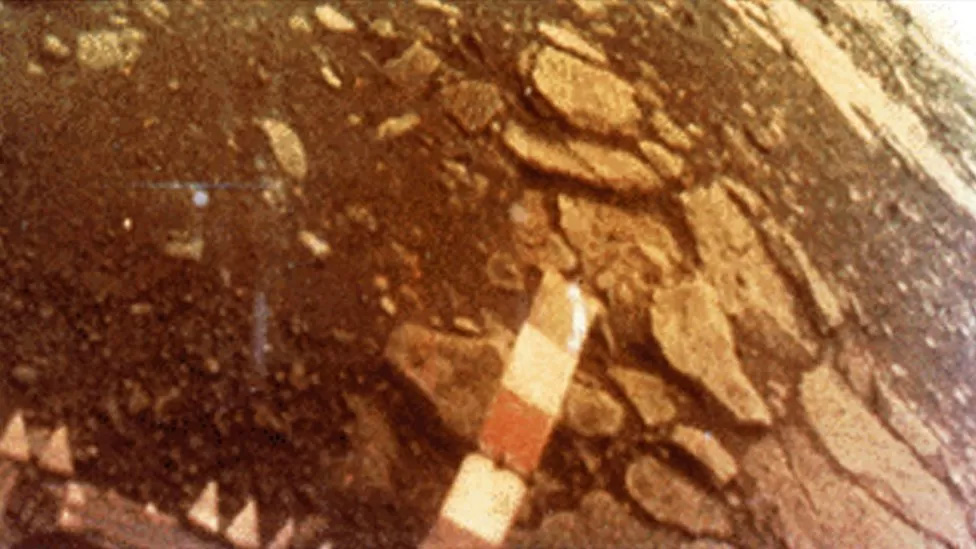Ten Facts about Venus
Shining brightly in the early evening sky is beautiful Venus. Some might even call it a summit of beauty and love. But, as these facts demonstrate, Venus is not quite as attractive is it might first appear.
Venus is the second planet from The Sun in the Solar System
Venus orbits The Sun at an average distance of about 108 million kilometres (67 million miles). It is situated in between the orbits of Mercury and Venus. Mercury is 58 million kilometres (36 million miles) from The Sun; Earth is 150 million kilometres (93 million miles) from The Sun.
Venus is the sixth largest/third smallest planet in the Solar System
Venus isn't much smaller than its neighbour Earth, having a diameter of 12,104 kilometres (7,521). Earth is only 638 kilometres (397 miles) wider than it. The only planets smaller than Venus in the Solar System are Mars and Mercury.
A day on Venus is longer than its year. It also rotates backwards!
Venus takes 224 Earth days to complete one orbit of The Sun, but 243 to rotate once on its axis. This means that a year on Venus is 224 days, but a day is 243 days. Venus spins slower than any other planet in the solar system so has the longest day of them all. It also rotates in the opposite direction to most of the planets, spinning in a clockwise direction rather than anti-clockwise. The suggests that at some point in time, a large object collided with Venus and affected its rotation. Some scientists think that Venus might be upside-down, which in a confusing way means it is actually spinning in an anti-clockwise direction - it just appears to be rotate clockwise due to being the wrong way up.
Just to confuse things even more, the atmosphere of Venus rotates much faster than the surface below it, taking only four days to make its way around the planet. This is called super-rotation.
Note: scientists call a full rotation of a planet a sidereal day.
Venus was the first planet to be visited by a space craft
On 14th December 1962, NASA's Mariner 2 flew past Venus. This marked the very first time any planet (other than Earth itself) had been visited by a spacecraft. Although Mariner 2 wasn't equipped with a camera so couldn't send back any pictures, it still sent back data about the conditions at Venus. The first spacecraft to take photos of Venus was Mariner 10 in 1974.
Even though it isn't the closest planet to The Sun, Venus is the hottest planet in the Solar System
Mariner 2 discovered that temperatures on Venus are a terrifyingly toasty 471 °C (880 °F), the highest measured of any planet in the Solar System. This makes Venus even hotter than the closest planet to The Sun, Mercury.
The main reason for Venus' high temperatures is that its atmosphere contains a dense layer of carbon dioxide which is topped off with a thick layer of clouds of sulphuric acid. These conditions mean that the heat that Venus receives from The Sun gets trapped and cannot escape back into space. Temperatures are the same all over the planet, regardless of whether they are measured on the day side or on the night side, at the equator or at its poles. Temperatures are so hot on Venus that the surface glows.
Venus is the third brightest object in the sky after The Sun and The Moon
From a distance, Venus is a bright beautiful object. Its proximity to The Sun and also to Earth means that it's in an ideal place to be seen. Planets and moons do not produce their own light. They reflect the light that they receive from the Sun. The main cause of Venus' brightness is its clouds. Venus' clouds are so thick that about 70% of the light received from The Sun is reflected.
It's (almost) impossible to see the surface of Venus from afar
Venus thick thick clouds cover the entirety of the planet. The clouds never clear and mean that any passing spacecraft are unable to peak through them to see what Venus' surface looks like. That is unless they have special magical powers. Or, if magical powers are in short supply, they could use radar. Radar works by sending radio signals to the surface of something and bouncing them back. These signals can work out things like the distance and brightness of an object, and turn them into a virtual image. NASA's Magellan spacecraft used radar to map the surface of Venus between 1990 and 1994 while orbiting it.
Only 10 spacecraft have successfully landed on the surface of Venus
One way of viewing the surface of Venus is by landing on it. This is easier said than done as conditions at Venus are horrifying and getting a spacecraft to land and survive on its surface is quite a challenge. The Soviet Union sent Venera 7 in 1970, Venera 8 in 1972, Veneras 9 and 10 (1975), Veneras 11 and 12 (1978) and Veneras 13 and 14 (1981). The USA sent Pioneer Venus 2 in 1978 which released three probes to its surface. Two of them survived the landing. As the temperature at Venus' surface is hot enough to melt lead, and the pressure feels like being 1 kilometre under water, none of the spacecraft survived for very long. Venera 13 lasted the longest, managing to operate for over two hours before being destroyed by Venus' harsh conditions. No human beings have ever visited Venus.
Venera 9's photos from the surface of Venus were the first from the surface of another planet
Of the 10 missions that landed on Venus' surface, only four were able to send images back to Earth. Venera 9 took a black and white panaroma from the surface in 1975. Venera 10 sent back another in 1976, while colour images were taken by Venera 13 and Venera 14 in 1982.
The pictures revealed a planet with a yellow sky and a rock-strewn surface.
The surface of Venus is covered by volcanoes and ancient lava flows
Venus has the most volcanoes of any planet in the solar system. Over 1,600 major volcanoes are known on Venus, and there may be tens or even hundreds of thousands more smaller volcanoes there. It is thought that major volcanic events as recent as 500 million years ago (that's recent in space terms!) resurfaced much of Venus' surface.
It is not known if Venus is still volcanically active, although some scientists suspect that a small number of volcanoes may be. No eruptions have yet been detected.
Venus can usually be observed just after sunset or just before sunrise
Because Venus is situated in between Earth and The Sun, it means that it can only be seen from the side of Earth facing The Sun. When Earth is facing The Sun, it is daytime which makes seeing Venus very difficult as the sky is too bright. It is only shortly after The Sun has set or shortly before it rises that the sky is dark enough for Venus to be visible. For this reason, Venus has also been known in the past as the Morning Star and the Evening Star.
Venus does not have a moon
Venus is one of two planets in the Solar System not to have a moon. The other planet without a moon is Mercury. It is not fully understood why Venus doesn't have a moon. A likely reason might be that because Venus is fairly close to The Sun, a moon orbiting it wouldn't be able to maintain a stable orbit due to the gravitational forces of Venus and the Sun.
Venus is the planet of Love!
Venus is named after the Roman goddess of Love and Beauty. In Greek mythology, the equivalent goddess is Aphrodite. It likely got this name due to its brightness in the night sky, appearing as the most beautiful of all the planets. It is the only planet named after a female god.
Europe headed for Venus in 2005... and to the top of the charts in 1986
The European Space Agency's first mission to Venus was Venus Express. It launched in 2005, reached Venus in 2006 and remained active in orbit of the planet until 2014.
Another Europe has also headed for Venus. Europe was the name of a Swedish rock group who sang about leaving Earth and heading for Venus in their hit song The Final Countdown, released in 1986. The song topped the charts in countries all over Europe. Bob the Alien is a big fan of the song!







